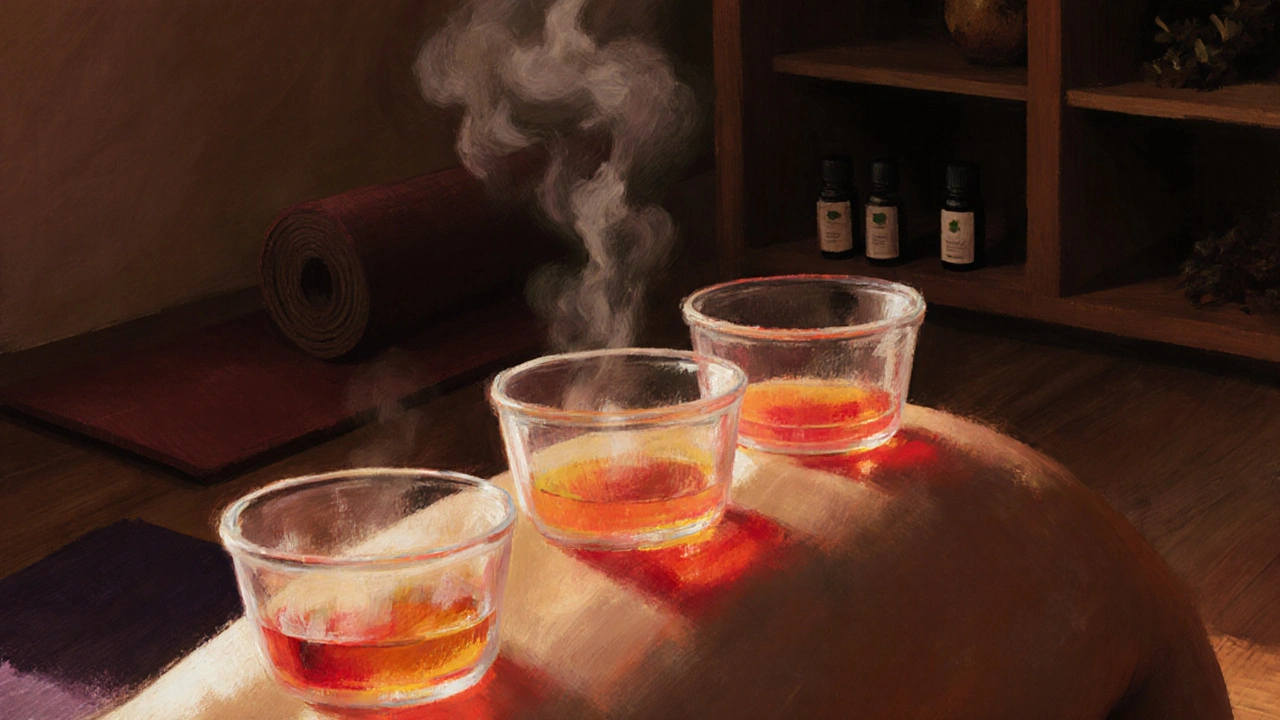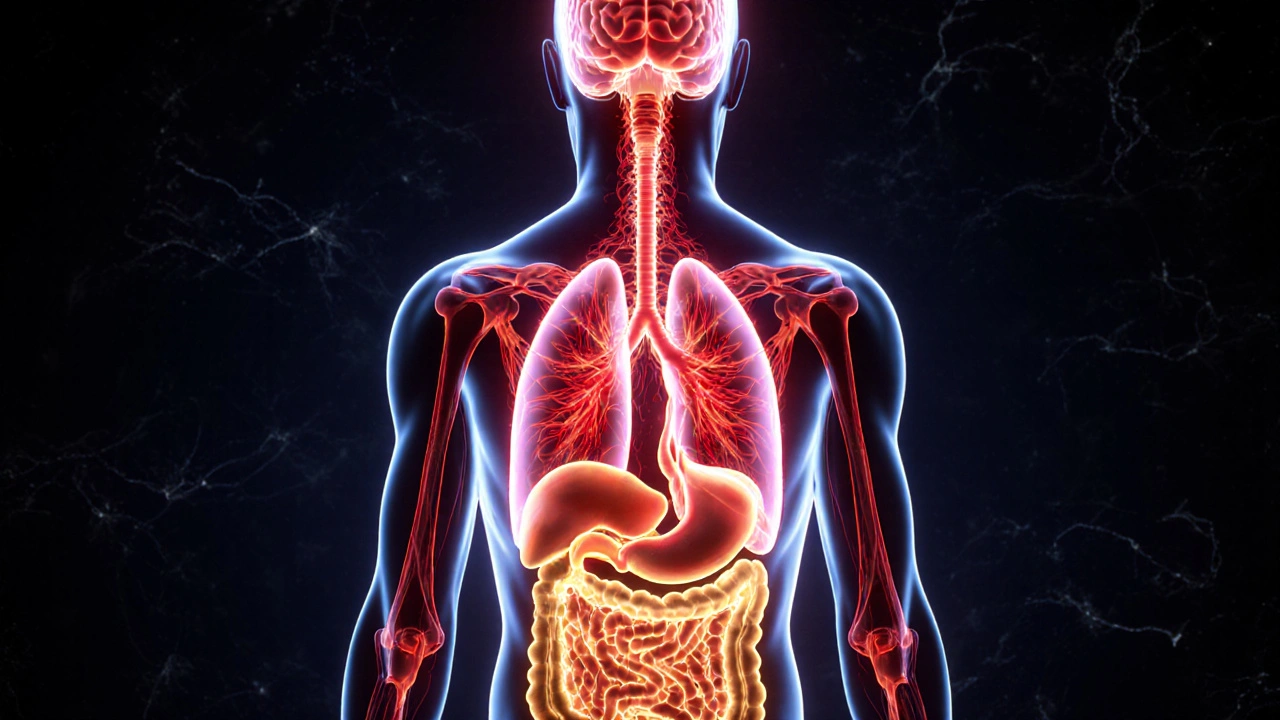10 Surprising Benefits of Cupping Therapy Backed by Real Experience
 Nov, 15 2025
Nov, 15 2025
Cupping Therapy Recovery Estimator
How Long Until You Feel Better?
Based on research showing cupping therapy reduces recovery time by 30-60% for various activities. Enter your activity type and pain level to get personalized estimates.
Recovery Estimate
Your estimated recovery time with cupping therapy:
[Estimation]
People think cupping therapy is just an old folk remedy with weird-looking glass cups stuck to your back. But if you’ve ever seen an Olympic swimmer with circular bruises on their shoulders, you know it’s more than that. Cupping isn’t new-it’s been used in Chinese, Egyptian, and Middle Eastern medicine for thousands of years. Today, it’s not just for traditional healers. Athletes, physical therapists, and even busy office workers are using it to recover faster, reduce pain, and feel more relaxed. The truth? The benefits go way beyond what most people assume.
1. Reduces Chronic Muscle Pain Without Drugs
If you’ve tried ibuprofen, heat packs, and stretching for your lower back or neck pain, and nothing sticks, cupping might be the missing piece. Unlike painkillers that mask symptoms, cupping works by increasing blood flow to tight, sore areas. The suction pulls stagnant fluid and toxins away from the muscle tissue, bringing fresh oxygen and nutrients in. A 2022 study in the Journal of Traditional and Complementary Medicine found that participants with chronic neck pain who got weekly cupping sessions reported 40% less pain after four weeks-without any medication. The marks you see? They’re not bruises from injury. They’re signs your body is flushing out inflammation.
2. Speeds Up Recovery After Workouts
Elite athletes don’t use cupping because it looks cool. They use it because it works. After a hard training session, muscles accumulate lactic acid and micro-tears. Cupping helps clear those by improving circulation. NBA players like Lebron James and NFL stars like Tom Brady have openly used it. Even weekend warriors swear by it. One runner I talked to said his post-marathon soreness dropped from five days to two after adding cupping to his routine. It’s not magic-it’s physics. The suction creates negative pressure, which pulls fluid out of tight spots and helps your lymphatic system drain waste faster.
3. Improves Range of Motion and Flexibility
Stiff shoulders? Tight hamstrings? Cupping doesn’t just relax muscles-it helps reset the nervous system. When tissue is stuck in a tense state, your brain keeps signaling it to stay tight. Cupping interrupts that signal by creating a gentle stretch in the fascia, the connective tissue that wraps around your muscles. A 2023 trial with 80 yoga students showed a 27% increase in hip flexibility after just six cupping sessions over three weeks. You don’t need to be flexible to benefit. If you sit all day, cupping can help undo the stiffness that builds up in your hips, lower back, and chest.
4. Eases Symptoms of Fibromyalgia and Chronic Fatigue
People with fibromyalgia often describe their pain as deep, burning, and exhausting. Traditional treatments rarely help long-term. But cupping has shown real promise. A 2021 clinical review of 12 studies found that cupping therapy significantly reduced pain intensity and improved sleep quality in fibromyalgia patients. The theory? Chronic pain conditions often involve poor circulation and buildup of inflammatory markers. Cupping helps move those out. One woman I spoke with, diagnosed with fibromyalgia for 12 years, said after three months of weekly sessions, she stopped relying on sleep aids and could walk her dog without needing to lie down afterward.
5. Helps With Headaches and Migraines
Most migraine treatments focus on blocking nerve signals or reducing inflammation in the brain. But what if the trigger is in your neck? Tension headaches and even some migraines start from tight muscles in the upper back and neck. Cupping on the trapezius muscles and base of the skull can release that tension before it turns into a full-blown headache. A small 2020 study with 50 migraine sufferers showed a 50% reduction in frequency after eight biweekly cupping sessions. No pills. No side effects. Just relief from the pressure building up in your shoulders.

6. Boosts Skin Health and Reduces Cellulite Appearance
Yes, cupping can help your skin. The suction increases blood flow to the surface, which stimulates collagen production and improves skin elasticity. It also breaks up the fat pockets that cause cellulite by loosening the connective tissue underneath. It’s not a magic erase button, but it’s one of the few non-invasive methods that actually shows measurable results. Women who’ve tried it for cellulite on their thighs report smoother skin after four to six sessions. It’s often combined with massage oil to glide the cups, leaving skin looking brighter and less dimpled.
7. Supports Digestion and Reduces Bloating
You might not think of cupping when you’re bloated after dinner, but it’s used in traditional Chinese medicine for digestive issues. When cups are placed along the stomach and lower back meridians, they stimulate the vagus nerve-the main nerve connecting your brain to your gut. This helps regulate digestion, reduce gas, and ease constipation. One man with chronic IBS said his bloating dropped from daily to once a week after just five sessions. It’s not a cure, but it’s a gentle way to reset your system without laxatives or probiotics.
8. Lowers Stress and Improves Sleep
Cupping triggers your parasympathetic nervous system-the part that says, “It’s safe to relax.” The slow, rhythmic suction feels like a deep massage, and your body responds by lowering cortisol levels. A 2023 study in Complementary Therapies in Clinical Practice found that people who did cupping twice a week for a month reported 35% less stress and fell asleep 20 minutes faster on average. If you lie awake at night replaying your day, cupping can be a reset button for your nervous system. You don’t need to be in pain to benefit. Just feeling overwhelmed? Try it.
9. Helps with Respiratory Issues Like Asthma and Bronchitis
In traditional medicine, cupping on the upper back has been used for centuries to clear congestion. Modern research backs this up. The suction helps loosen mucus in the lungs and opens up restricted airways. A 2021 trial with 60 asthma patients showed improved lung function and fewer emergency visits after six weeks of cupping. It’s not a replacement for inhalers, but it’s a powerful complement. People with chronic bronchitis or seasonal allergies say they cough less and breathe easier after sessions. The cups are placed between the shoulder blades and along the spine-areas rich in nerve endings that connect to the lungs.

10. Enhances Mental Clarity and Focus
This one surprises most people. But if you’ve ever felt mentally foggy after a long day, cupping can help. The therapy reduces physical tension, which often mirrors mental stress. When your body is tight, your brain stays on high alert. Cupping signals safety, which quiets the mental chatter. One software developer told me he started doing cupping before big coding sprints-and suddenly found he could focus for hours without needing coffee breaks. It’s not a stimulant. It’s a reset. Less physical noise means more mental space.
What to Expect During a Session
A typical cupping session lasts 20 to 30 minutes. The therapist places glass, silicone, or plastic cups on your skin-usually on your back, shoulders, or legs. Suction is created either by heat (in traditional glass cupping) or a hand pump (in modern silicone versions). The cups stay on for 5 to 15 minutes. You might feel a gentle pulling sensation, like a deep massage. Some people feel immediate relief. Others feel nothing until hours later. The marks left behind range from light pink to dark purple and usually fade in 3 to 10 days. No needles. No drugs. No downtime.
Who Should Avoid Cupping
Cupping is safe for most people, but not everyone. Avoid it if you have: open wounds, skin infections, blood clotting disorders, or are pregnant (especially on the abdomen or lower back). People on blood thinners should consult their doctor first. Don’t try it if you’re prone to fainting-the sensation can be intense for some. Always go to a licensed practitioner. DIY cupping kits sold online? Skip them. Improper use can cause burns or bruising that lasts too long.
How Often Should You Do It?
For acute pain or recovery: once a week for 3-4 weeks. For maintenance: every 2-4 weeks. Athletes often do it after big events. People with chronic conditions like fibromyalgia benefit from weekly sessions for months. You don’t need to do it forever. Many people start with a few sessions, notice a change, and then use it as needed-like a tune-up for your body.
Does cupping therapy really work, or is it just a placebo?
It’s not just placebo. Multiple clinical studies have measured real physiological changes-increased blood flow, reduced inflammation markers, improved range of motion, and lower pain scores. The marks left behind are evidence of tissue response, not just perception. While some benefits may feel subjective, the measurable outcomes in peer-reviewed research make it more than a trend.
Are the dark marks from cupping dangerous?
No, they’re not bruises from injury. They’re areas where capillaries have released a small amount of blood due to suction. They’re harmless and fade naturally in 3 to 10 days. Darker marks usually mean more stagnation in that area, not more damage. If marks last longer than two weeks or are painful, stop and consult a professional.
Can I do cupping at home with a kit?
You can, but it’s not recommended. Without proper training, you risk applying too much suction, causing burns or skin damage. You might also miss key areas or apply pressure where it’s unsafe, like over the spine or kidneys. Licensed practitioners know anatomy and contraindications. Save the DIY kits for decoration.
How is cupping different from massage?
Massage pushes tissue down and around. Cupping lifts and pulls. It creates negative pressure, which draws fluid out of tight areas instead of compressing them. This makes it especially effective for deep fascial restrictions that massage can’t reach. Many people combine both-massage first to warm up, then cupping to release.
Is cupping therapy covered by insurance?
Rarely. Most insurance plans don’t cover it because it’s considered alternative. But some flexible spending accounts (FSAs) or health savings accounts (HSAs) allow it if prescribed by a licensed provider. Always check with your provider first. The cost usually ranges from $40 to $100 per session, depending on location and practitioner.
Next Steps
If you’re curious, start with one session. Find a licensed acupuncturist, physical therapist, or certified cupping specialist. Ask if they use silicone or glass cups-silicone is gentler for beginners. Don’t expect miracles after one visit. Give it three sessions to see if your body responds. Track how you feel: sleep, pain levels, energy, mobility. If you notice even small improvements, it’s worth continuing. Cupping isn’t a cure-all. But for many, it’s the missing tool that finally helps them feel like themselves again.
